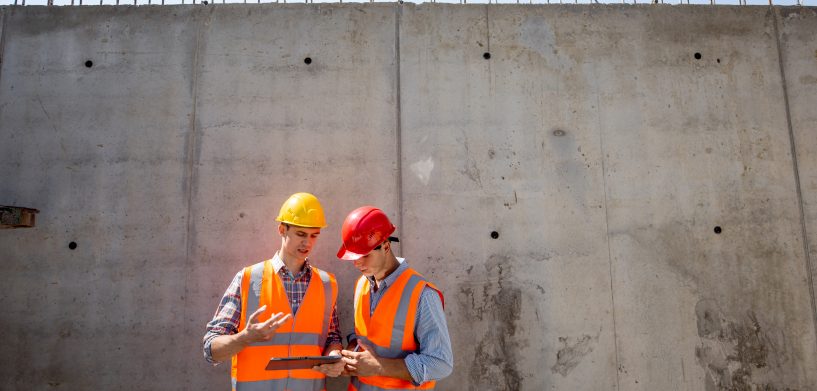The construction sector is one of the largest contributors to the world economy with about $10 trillion spent on goods and services annually. Yet, according to the McKinsey Global Institute, productivity in the sector trails far behind that of other critical industries. Learn the complex processes involved in construction management and how digital tools can close the productivity gap while improving quality and reducing risks.
What is construction management in industry terms?
The construction management industry consists of skilled professionals who orchestrate construction projects from planning to closeout. Also known as building construction management or construction project management, the discipline is defined by the Construction Management Association of America (CMAA) as ‘a professional service that provides a project’s owner(s) with effective management of the project’s schedule, cost, quality, safety, scope and function’.
To fully understand the construction management definition, it helps to know who participates in large building projects. Key stakeholders and their roles generally include:
- The owner who commissions and finances the project
- The engineers and architects who design the site and facility
- The general contractor who oversees operations and manages subcontractors
- The construction manager who coordinates with stakeholders to ensure delivery on time, within budget and to the owner’s satisfaction
Each of these individuals or firms plays an important role in some or all phases of a major construction project. In most cases, it is the construction manager’s job to work cooperatively with every stakeholder to ensure the project is completed successfully.
What do construction managers do?
What do construction managers do and what matters about construction management? According to the CMAA, a construction manager performs wide-ranging tasks such as these:
- Estimate and negotiate project costs with contractors.
- Develop a budget and cost-control measures.
- Create achievable timetables, work orders and labour schedules.
- Procure materials and track material inventory.
- Choose the strategy and methods appropriate for the project.
- Communicate with owners and other stakeholders.
- Lead and interface with construction teams and back-office personnel on technical and administrative details.
- Work with building and regulatory experts to comply with all relevant laws, codes and environmental considerations.
What are the phases of a construction project?
A construction project occurs in four general phases: planning, pre-construction, construction and closeout. Each phase comprises multiple tasks performed by craftspeople and other skilled professionals. Tasks within each phase might overlap into other phases, but the construction manager must ensure that work is done in the correct order and that deadlines are met.
Planning
Any construction project should be built on the foundation of a carefully crafted plan. This usually begins when the project owner kicks off phase one by determining the following:
- The type of building or structure required for the purpose
- Specific requirements, such as capacity and sustainability
- Project scope, budget and estimated timeline
- Criteria that will determine successful project completion
As these areas are being developed, the construction manager (if already selected), architects, engineers and other consultants coordinate to determine feasibility, required resources, environmental impacts and appropriate risk mitigation measures.
Pre-construction
When this phase begins, a construction project manager steps in, if one is not already onboard. In some projects, the manager is selected in the planning stage at the discretion of the owner.
During pre-construction, the project manager is expected to:
- Secure appropriate permits from local, regional and/or national authorities.
- Hire the remainder of the personnel needed for the project, including field supervision and office administration.
- Complete a site investigation and preparation, including environmental considerations.
- Consider best-practice risk management to ensure safety and reduce the need for change orders by resolving issues early.
- Initiate material procurement and material handling procedures.
Construction
Once planning is complete, groundbreaking and construction can begin. During the physical construction of the building, ongoing project management needs include:
- Creating and managing work orders
- Overseeing contractors and their subcontractors
- Ensuring team collaboration proceeds smoothly
- Monitoring of physical safety and other risks
- Budgeting and cost control of materials and labour
- Performing ongoing quality and conformance inspections
- Maintaining insurance requirements
- Reviewing and approval of technical submittals
- Responding to Requests for Information (RFIs)
- Scheduling accurate and timely payments for workers
- Keeping all stakeholders informed
- Working with all teams to solve problems as they arise
Closeout
At this final phase, physical construction has been completed and the facility is passed from the manager to the owner. Components of a typical project closeout include:
- Punchlist. The project manager and architect perform a walkthrough to note final changes that must be completed before hand-off.
- Inspections. The project manager and other experts inspect the premises to grant approvals or uncover any issues that still need attention.
- Cleanup. The project manager ensures all debris is hauled away, temporary utilities are removed and rented equipment is returned.
- Documentation. The project manager gathers and verifies all paperwork from designers, engineers, general contractor, subcontractors, financial institutions and others.
- Training. The project manager and assignees coordinate with the owner to ensure the new occupants can properly operate the facility.
What kind of tools exist to manage construction?
Construction managers are responsible for innumerable tasks during a large construction project. Whether digital or not, construction project management tools must address all key elements of the project, as outlined below.
Time and materials
The ability to easily track worker hours, order materials, create work orders, plan schedules and budgets, create checklists, create daily reports and perform related tasks is critical during a large construction project. Tools such as time tracking software, materials management applications and inventory management software provide access to accurate, real-time information about which resources are available and when. Whether the tools used are digital (integrated applications or individual spreadsheets and files) or manual, they are essential to the orderly and successful completion of a project.
Asset tracking
Tools that enable equipment tracking and traceability make it possible to plan the most efficient deployments and determine where and when additional equipment must be purchased or rented. These tracking tools provide precise asset locations, usage and repair histories and current calibration data to verify readiness. This allows the construction manager to prevent the waste of time, labour and money that transpires when essential equipment is either not available or not in working order.
Field services
Managing field services, or non-construction activities, such as equipment and fleet maintenance, play an integral role in any large construction project. Optimal performance of these services is consequently a key contributor to profitability. To reduce bottlenecks, tools that help manage fleet resources, schedule preventive and predictive maintenance and anticipate the need for assets in the field are invaluable to construction managers. The right field services tools, such as computerised maintenance management software (cmms) improve distributed services and keep the project rolling smoothly.
Operations
A multitude of tools exist to empower construction managers to coordinate with teams, connect disparate workflows, analyse data, perform productivity tracking and make smart decisions across operations. It is up to the construction manager to choose the best tools with the ability to scale up or down, integrate data and provide current information to every stakeholder as needed.
Until recently, construction project management tools have largely consisted of manual processes and siloed computer applications limited to a single function, such as construction scheduling or payroll. In fact, much of the industry’s lackluster productivity is explained by its struggle to deploy state-of-the-art digital tools and systems at scale. A 2019 research report from consulting firm, JBKnowledge identified these statistics:
- Approximately 40 percent of today’s construction companies use paper plans on the job.
- Nearly 50 percent of construction professionals use manual daily reporting methods.
- Of those who use software applications, 53 percent must manually transfer data from one application to another.
Along the same lines, McKinsey found that technology spending in construction averages just 1.2 percent of revenue, with more than one-third of companies spending less than one percent. With over-reliance on old-school, manual methods, it is understandable that construction productivity lags behind its counterparts. The reluctance to adopt productivity-enhancing digital tools leads to preventable mistakes, longer delays and ultimately, lower profit margins across the board.
Benefits of construction management software
So, what is the solution? Forward-thinking firms are revolutionising their workflows with software solutions that integrate key project management functions. Holistic construction project management software integrates crucial information, adding value to all your project management efforts.
- Enables optimal resource and work order scheduling
- Empowers a distributed mobile workforce
- Allows easy document management and sharing
- Facilitates risk identification, prevention and mitigation
- Improves the quality inspection process
- Promotes information sharing from anywhere
- Builds owner confidence for a competitive edge
Let us further explore how these capabilities benefit every phase of your construction project.
Enables optimal resource and work order scheduling
The importance of resource management and construction scheduling, including expected start and end date for each task, cannot be overstated. The project manager is responsible for creating an achievable schedule of workers’ hours, shipments of materials and benchmark goals. A savvy project manager also anticipates possible points of vulnerability, such as employee time off or inclement weather, and creates contingency plans to accommodate these events. Digital tools for construction daily reporting, work order scheduling and employee time tracking software help the construction manager assign the timing and method of resource utilisation.
Empowers a distributed mobile workforce
The ability to access and share information need not be limited by geography. With construction management tools available on smartphones and tablets, authorised personnel can stay in the loop from any location with Wi-Fi or mobile service. This improves efficiency by cutting out time and labour spent returning to the office to update status, log hours, order supplies and perform other administrative tasks.
Allows easy document management and sharing
Construction companies generate large amounts of paperwork, such as inspection documents and audit logs. Many construction companies still primarily use paper that must be physically filed, copied and transported, which slows down the document management process. Conversely, electronic document management simplifies and speeds up tasks associated with creating, tracking and accessing information.
Facilitates risk identification, prevention and mitigation
Minimising risks to people and property is essential to any construction project. However, large infrastructure projects often fail to identify risks. These risks crop up at every stage of construction, and the chronic undermanagement of these pitfalls routinely causes the loss of assets and profits. Even worse, they can lead to a hazardous environment for people onsite.
Disjointed sources of information, such as information silos created by manual processes or applications that do not work together, compound to obscure the existence of risks. On the flip side, digital solutions exist to solve these complex issues. The ability to tie information together in a single software system enables the project manager to anticipate risks and mitigate problems early – before they become hazardous or costly.
Improves the quality inspection process
Quality is the foundation of any successful construction project. Digital tools that standardise and mobilise the quality inspection process ensure that quality is front and center throughout the project. Tightly integrated with your business workflows, effective quality inspection promotes best practices, assures that workmanship and materials are free from defects and all elements of the facility conform to the highest quality standards.
Promotes accurate information sharing from anywhere
Mobile solutions compatible across operating systems, platforms and web browsers empower your distributed workforce from the office to the field. This ensures that all authorised users can enter status updates and access the same accurate and current information, regardless of where they are located.
Builds owner confidence for a competitive edge
It is clear evidence that a construction project is professionally managed when it builds confidence in your firm’s abilities and enhances your reputation. The right software tools will yield proven results that grow your business year after year.
REVOLUTIONISE YOUR WORKFLOWS
Hexagon Xalt transforms your construction management workflows from the office to the job site and to anywhere in the field. These digital solutions accelerate productivity from project planning to closeout. Xalt offers integrated mobile solutions for these critical tasks and more:
- Work order scheduling and management
- Construction daily reporting
- Employee time tracking
- Equipment tracking and traceability
- Equipment downtime tagging
- Material requisition and handling
- Quality inspection with root cause analysis
What is the future of construction management?
While falling behind other critical industries in terms of productivity, the construction industry is undergoing its own transformation. Better tools and business models will inevitably evolve the industry, but investments must meet the growing need to bridge the gap with other industries.
A recent Globe NewsWire media release highlights a 2019 report from Research and Markets that summarises the coming impacts through the year 2030.
- Digitisation will enable more powerful solutions, such as building information management (BIM) tools, decision support with artificial intelligence and accelerated data transfer through 5G connectivity.
- Autonomous technologies, such as robots that perform specific jobs, will increase precision, minimise human error and reduce the need for a human presence in some hazardous situations. This will require construction managers to build new skills related to understanding how these technologies affect the jobsite and the labour force.
- Sustainability will go beyond regulatory compliance as companies choose to play a role in conserving resources and reducing their carbon footprint. Prefabricated, modular designs will improve compatibility across projects, generate economies of scale, raise productivity and result in higher profit margins.
- New business models will be driven by data and technology and designed for optimal collaboration among stakeholders. This has been a persistent pain point in large construction projects.
- Social and economic trends will accommodate the needs and expectations of a highly diverse workforce and owner base. Unstable economies and changing trends will require creative applications of advanced technologies, including autonomous vehicles and equipment.
The future of construction management is digital. In the coming years, new technologies will allow construction projects to be more productive, efficient, collaborative and sustainable. This is a critical moment for the construction industry, and companies will need to embrace new innovations in order to continue to grow and compete in the industry.
Ready to accelerate your digital transformation? Construction management applications from Hexagon Xalt can help. Visit hexagonxalt.com, request a demo or call toll free at +1 800-939-6812.



















